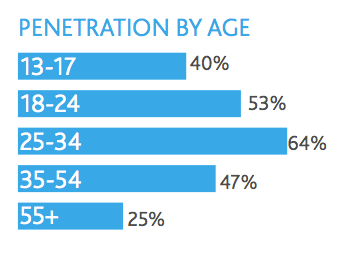Twitter Now A Top 3 Site For iPhone Users — Nielsen
- Fahad H

- Dec 16, 2011
- 2 min read
Nielsen recently released a collection of Q3 US smartphone data, some of which it had been trickling out in blog posts over the past month or so. It’s a bit like a “greatest hits” record. But seeing it all together in one document — some of the data are based on user surveys and some on behavior — is striking because it clearly demonstrates how powerful and important mobile is now.
In 2009 only 18 percent of US mobile subscribers owned a smartphone. Currently the figure is 44 percent. In 2009 the top mobile handset was the Motorola Razr V3; as 2011 ends it’s the iPhone. However Android is the dominant smarpthone operating system.

Smartphone ownership has thus more than doubled in two years. If that kind of growth continues, by the end of 2013 more than 75 percent of US mobile phone owners will have smartphones. Some groups are almost there already: 64 percent of Americans 25–34 and 53 percent of 18–24 year olds today have smartphones.

The average number of apps on smartphones is 33. Android owners have an average of 32, according to Nielsen’s data, while iPhone owners have an average of 44 apps on their phones. However, 83 percent of all smartphone-app downloaders in the past 30 days are iPhone or Android owners. Most usage is concentrated in a cluster of top apps, which are “constantly changing” according to Nielsen.
Most US smartphone users discover apps by searching the iTunes Store or Android Market. After that they learn about apps via word of mouth, according to Nielsen survey findings (n= 5,000).


Facebook is essentially the app with the greatest “active reach” on Android and it’s one of the top apps on the iPhone. The “mobile web, however, looks much like the PC web in terms of the hierarchy top sites or networks, with some notable exceptions: Twitter and PayPal rank very highly for iPhone users.

Twitter recently spoke about how deep integration into iOS 5 has boosted the company’s usage significantly. The Nielsen data above would appear to validate that claim. Twitter isn’t among the top sites for Android users interestingly.
Among the 49 percent of smartphone users who downloaded an app in the past 30 days, 87 percent say they’ve used daily deal apps/sites. The top three are Groupon (79 percent), LivingSocial (48 percent) and, in a bit of surprise, Yelp (9 percent). While Groupon and LivingSocial dominate daily deals on the PC, Yelp is far below others such as AmazonLocal and Google Offers, which aren’t among the top 10 in mobile right now.
Finally, 54 percent of US smartphone owners report that they use their devices “frequently” while shopping — in other words in or near the store. This creates new ways to reach and influence consumers, which are just beginning to be explored by marketers.
Hopefully all the “is this the year of mobile?” jokes and nonsense are over.
Clearly 2011 was a year in which smartphone penetration reached a version of critical mass. We are seeing the results and consequences of that in consumer behavior as well as new challenges and imperatives for marketers — most of whom are still scrambling to make sense of it all.








Comments